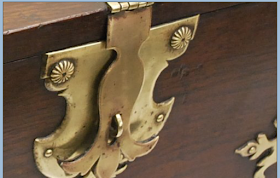Written by the TreasureGuide for the exclusive use of treasurebeachesreport.blogspot.com.
 |
2-inch Long Pierce of Copper With Rolled Edge.
Find and photo by Bill M.
|
People often think first of sheathing when they find a piece of copper on a wreck beach, but copper was a common metal used for a variety of things. For example, copper kettle parts and patches are among the most common artifacts found at 18th century archaeological sites. Below are just some of the examples from one site described by Timothy McGuire in his book, Recovered Colonial and Revolutionary War Artifacts (Leprechaun Press, 2013).
Pots and kettles were patched over and over again until the object was unrepairable, and then the pieces would be repurposed or finally discarded.
The following photo shows the rolled seam on an old copper kettle that I once found.
 |
| Seam on Old Copper Kettle. |
I'm thinking that the piece found by Bill M. could be from something like that with the seam torn apart.
Flat thin pieces of metal can often be found near the surface. Shape is one characteristic that is seldom mentioned when it comes to how things move on a beach. People tend to think mostly of density.
Here is a web site that discusses how to determine the age of antique copperware.
https://frenchkitchenantiques.com/copper
Look for signs hand-hammering, dovetailing and rivets.
Here is more on rivets.
Rivets

To attach the iron or brass handles to copper vessels rivets were used for making strong joints. Rivets could be made from a variety of materials, but the most common ones are made of copper.
These would be carefully hammered into a round shape to fit the hole. Light hammer marks can often be seen on the surface of the rivet and are a good way of telling modern and antique kitchenware apart.
---I posted the mystery find shown below a day or two after digging it on 1/22 and asked for opinions.
 |
| Mystery Find. |
Among the excellent thoughts, DJ thought it might be a hasp and provided the following photo that shows a hasp, although a more ornate and perhaps larger one.
 |
Hasp Example
Submitted by DJ
|
---
A couple weeks ago Joe D. was hunting a park and found the 40% silver Kennedy half shown below.
Silver Half
Find and photo by Joe D.
|
Joe mentioned it was found in a junky area and didn't give a great signal.
Congratulations Joe.
--- ---
---
With the recent offshore winds and small surf, you might be able to find some nice spots for a little low-tide hunting. No big surf is expected for a while.
I still have a variety of topics to discuss. I plan on doing more on beach dynamics. Several people told me they'd like to see more on that. Also more miscellaneous recent finds, and other topics.
Enjoy the cool weather,
TreasureGuide@comcast.net
With the recent offshore winds and small surf, you might be able to find some nice spots for a little low-tide hunting. No big surf is expected for a while.
I still have a variety of topics to discuss. I plan on doing more on beach dynamics. Several people told me they'd like to see more on that. Also more miscellaneous recent finds, and other topics.
Enjoy the cool weather,
TreasureGuide@comcast.net
https://www.seawear.com/claddagh-story-legend.html


